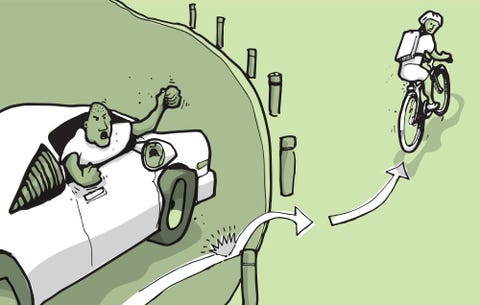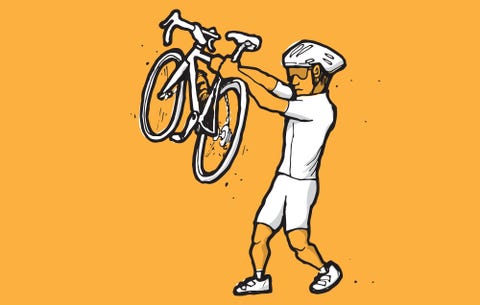Moments after the driver of a black pick-up truck buzzed Michael Robson last July, the 50-year-old Colorado cyclist faced death a second time. The driver was pointing a pistol at Robson’s chest.
Robson said he’d had some success in the past talking to careless drivers, and when he saw the parked truck and its driver pulled off the road moments after his close call, he decided to stop. What was meant to be an impromptu education lesson quickly escalated. An already irate driver grew angrier. Harsh words were exchanged. Then the driver allegedly pulled the weapon.
“He was already angry and just looking for an excuse to get his gun out,” Robson said. “And that’s what he did. It was a scary situation.”
Thankfully most riders haven’t had a gun pointed at them, but dealing with enraged drivers, sadly, has become commonplace in the United States. Over a recent seven-year period, more than 200 murders and 12,600 injuries were attributed to road rage, per AAA statistics. (It’s not known how many of those incidents involved drivers and cyclists.)
So how can a cyclist stay safe and avoid conflict when confronted?
Robson said a witness called Boulder police, who would arrest the driver who would later go on to plead guilty to felony menacing and a misdemeanor count of conspiracy to commit a prohibited use of a weapon, receiving two years probation, but no jail time.
Although Colorado-based bicycle attorney Megan Hottman knows of instances where cyclists and drivers were able to have a reasonable discussion about the finer points of right-of-way laws at a stoplight, she calls those moments the exception, not the rule.
“Most motorists raging at a cyclist don’t want to hear the rules and laws, and the cyclist trying to interact with them on the roadside often leads to escalation,” Hottman said. “With so many people packing weapons in their cars, I can’t ever recommend a cyclist try to engage with a motorist who has just demonstrated road-rage behavior.”
So what should cyclists do in a similar situation? Hottman suggests a few steps to start (and see 3 Approaches to Dealing With Road Rage below):
- Always ride with one or more video cameras and record the incident.
- Immediately pull over and call the local authorities, noting any identifying information about the vehicle and driver, including the direction of travel.
- Never engage the driver.
Unfortunately, the power dynamic will usually tip toward the aggressive driver armed with either a handgun or what’s essentially a two-ton metal battering ram. Cyclists can do everything right, “obey the laws, ride courteously, and do their part to keep the roads safe, but that isn’t going to prevent those riders from being the undeserving target of a motorist having a bad day, or someone who is intent on raging against a cyclist,” Hottman said.
Psychology Today cites several causes for road rage, such as a need for control or to feel superior. Robson suggests a lack of empathy and easy access to firearms are two of the root causes of road-rage incidents between drivers and cyclists.
“There’s a definite dehumanization aspect,” Robson said. “Drivers are usually coming up on us from behind, so they can’t see our faces. To them, we’re not people, just annoying objects that are slowing them down.”
Ultimately, it must be up to drivers to alter their bad behavior. But how do we make that happen? That’s the question that has experts and advocates stumped.
“Other than for everyone to start meditating and to slow the hell down on the roads and in life in general… How do we make mean people not mean? I wish I knew,” Hottman said.
Road-safety advocates have created advertising campaigns highlighting that cyclists are actual human beings—mothers, wives, sisters, daughters—but it’s not known how much of an impact those ads had. More stringent enforcement and harsher punishments have been suggested as well, but there’s not enough research to determine if that might work. Robson’s suggestion? Put drivers in a similarly vulnerable position.
“I’d love for drivers who target cyclists to be blindfolded and stood next to a busy highway, and let the vehicles pass them at 65 mph with inches to spare,” Robson said.
The incident changed Robson’s life, but he doesn’t believe the driver learned anything or has any remorse in the aftermath of the case.
“I had nightmares for a while, and that lack of sleep and nerves definitely affected my work,” Robson said. (Full disclosure: Robson is a freelance photographer who has done work for Bicycling in the past.) “I’m definitely not as social or outgoing as I was in the past. [The driver] essentially got a slap on the wrist. He’ll do it again.”
3 Approaches to Dealing With Road Rage
Angry drivers are always scary but far more so when you’re on a bike. Here’s how to safely get out of a bad situation. (By Joe Lindsey)
Defuse the Situation
It might feel good to flip the bird or yell at a driver who cut you off or did something aggressive with his car. But it might legally make you the instigator and can certainly escalate an already-volatile situation. You have no idea what’s going on in that driver’s head. And you have no idea whether they’re armed, for instance.
Whether a driver is packing or just pissed, it doesn’t really matter. “You’re at a disadvantage in so many ways,” says Fort Worth Police officer Jason Young, who is also a training coordinator for the Law Enforcement Bicycle Association. “Discretion is always the better part of valor.” If you’re verbally confronted (even if the accusation is wrong), don’t argue.
Hottman, goes further and says not to even engage. “I have never heard of a situation where a cyclist’s tone helped reverse things,” she said. “I’ve never seen it go from bad to good.”
Disengage From the Situation
For Hottman, the best tactic is just to get out. “Get to a place of safety,” she says. “If the person is exiting the vehicle (to confront you), ride away. There’s never a circumstance where it benefits you to stay present.”
Hottman said she’s jumped up on the sidewalk and done U-turns to get away from aggressive drivers. She also looks for potential witnesses. Their presence might help deter the driver from getting violent, but they’re also valuable if law enforcement gets involved. “If it’s just your word against the driver, the police likely won’t take action, but even one independent witness will be enough for them to make contact (with the driver),” she says. If you ride with a POV camera, that footage can be helpful, but police and courts won’t always consider it as evidence.
Try to note things like the vehicle make, model, color, and plate number; physical characteristics of the driver; and time of day and where the altercation occurred. The more details, the better.
Most state highway patrols and police departments have non-emergency phone contacts or web forms to report aggressive drivers.
Defend Yourself
If the driver is physically aggressive and you can’t get to a safe place, do everything you can to prevent violence. Call 911 right away and leave the call live even if you can’t talk to the dispatcher. Put your bike between yourself and the driver, and never get violent against a person or their vehicle even if you feel threatened, because legally that can make you the aggressor.
We're here to help!
At Clark & DiStefano we are attentive, always focusing on the needs of our clients. We develop strategies that are tailored to each individual case, and we treat our clients as strategic partners in achieving a common goal. We endeavor to think outside of the box and formulate cost-effective strategies. Lastly, we believe in prompt communications with clients so they have predictability for reserve setting and sufficient time for studied pre-trial evaluations and recommendations.
[forminator_form id="40"]



